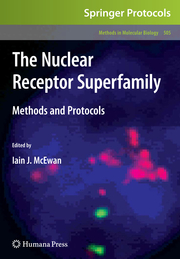-
Zusatztext
-
InhaltsangabePart I: Introduction 1. Nuclear Receptors: One Big Family Iain J. McEwan Part II: Ligand Binding and Nuclear Receptor Turnover 2. Methods for Measuring Ligand Dissociation and Nuclear Receptor Turnover in Whole Cells Elizabeth M. Wilson 3. Flow Cytometry as a Tool for Measurement of Steroid Hormone Receptor Protein Expression in Leukocytes Cherie L. Butts and Esther M. Sternberg 4. Xray Crystallography of Agonist / AntagonistBound Receptors Ashley C.W. Pike Part III: Nuclear Localization and DNA Binding 5. FRAP and FRET Methods to Study Nuclear Receptors in Living Cells Martin E. van Royen, Christoffel Dinant, Pascal Farla, J. Trapman, and Adriaan B. Houtsmuller 6. ReceptorDNA Interactions: EMSA and Footprinting Jason T. Read, Helen Cheng, Stephen C. Hendy, Colleen C. Nelson, and Paul S. Rennie 7. Chromatin Immunoprecipitation (ChIP) Methodology and Readouts Charles E. Massie and Ian G. Mills Part IV: Nuclear Receptor-Co-regulatory Protein Interactions 8. YeastBased Reporter Assays for the Functional Characterization of Cochaperone Interactions with Steroid Hormone Receptors Heather A. Balsiger and Marc B. Cox 9. High Throughput Analysis of Nuclear Receptor-Cofactor Interactions Michael L. Goodson, Behnom Farboud and Martin L. Privalsky 10. Binding Affinity and Kinetic Analysis of Nuclear Receptor/Co-Regulator Interactions Using Surface Plasmon Resonance Derek N. Lavery 11. Using RNA Interference to Study Protein Function Carol D. Curtis and Ann M. Nardulli 12. Using Intrinsic Fluorescence Emission Spectroscopy to Study Steroid Receptor and Co-Activator Protein Conformation Dynamics Kate Watt and Iain J. McEwan Part V: Pathophysiological Analysis of Nuclear Receptor Function 13. Development of Phosphorylation Site-Specific Antibodies to Nuclear Receptors Inés Pineda Torra, Julia A. Staverosky, Susan Ha, Susan K. Logan, and Michael J. Garabedian 14. TissueSelective Knockouts of Steroid Receptors: A Novel Paradigm in the Study of Steroid Action Karel De Gendt and Guido Verhoeven 15. Methods for Identifying and Studying Genetic Alterations in Hormone-Dependent Cancers Outi R. Saramäki, Kati K. Waltering,and Tapio Visakorpi
-
-
Kurztext
-
Acting principally to control patterns of gene expression, nuclear receptors play vital roles during embryonic development and in the regulation of metabolic and reproductive functions in adult life, which proves this superfamily of ligand-activated transcription factors to be a crucial part of biological life. In The Nuclear Receptor Superfamily: Methods and Protocols, expert researchers describe a range of molecular, structural and cell biological techniques currently used to investigate the structure-function of nuclear receptors, together with experimental approaches that may lead to new therapeutic strategies for treating nuclear receptor-associated diseases. Written in the highly successful Methods in Molecular Biology series format, the chapters in this volume contain brief introductions to the topics, lists of the necessary materials and reagents, step-by-step, readily reproducible laboratory protocols, as well as notes from the experts to highlight tips on troubleshooting and avoiding known pitfalls. Cuttingedge and easy to use, The Nuclear Receptor Superfamily: Methods and Protocols provides beneficial and timesaving guidance for all those undertaking research in this evergrowing field of study.
-
Detailansicht
The Nuclear Receptor Superfamily
Methods and Protocols, Methods in Molecular Biology 505
ISBN/EAN: 9781617379130
Umbreit-Nr.: 1516632
Sprache:
Englisch
Umfang: 240 S., 39 s/w Illustr., 4 farbige Illustr., 240 p
Format in cm:
Einband:
kartoniertes Buch
Erschienen am 19.11.2010
Auflage: 1/2009


